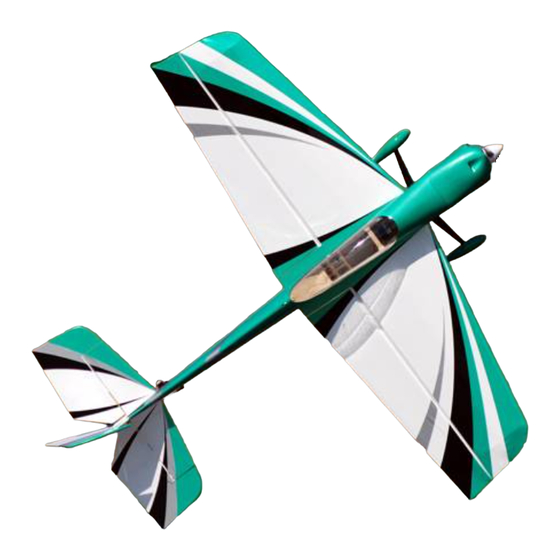3DHobbyShop.com Vyper 46" ARF Руководство по сборке - Страница 18
Просмотреть онлайн или скачать pdf Руководство по сборке для Игрушка 3DHobbyShop.com Vyper 46" ARF. 3DHobbyShop.com Vyper 46" ARF 19 страниц.

Scott's Tip:
Setting appropriate control throws is a critical step in matching your model to your
flying style. Personally, I use two different flight "modes"– precision and 3D. Depending
upon your radio, you may be able to combine all three dual rate functions onto a single
switch, which is the technique I use. Regardless, be sure to use a common assignment
scheme to prevent being in the wrong rate at the wrong time. I prefer my switches to be
higher for high rates and lower for low rates, but virtually any combination will work – just
be comfortable with your setup.
Low/Precision Rates (in degrees and inches) and Corresponding Exponential
Aileron
Elevator
Rudder
High/3D Rates (in degrees and inches) and Corresponding Exponential
Aileron
Elevator
Rudder
The above throw measurements were taken at the aft edge of the ailerons and
elevator, and from the bottom aft edge of the rudder. Keep in mind that even the low throws
mentioned here are relatively aggressive, so be sure to also program the matching
exponential listed to help soften the model's feel around center stick.
One of the things you may notice is that my low rates are dramatically lower than
you might expect. I find that I have such great control authority that I need to minimize the
elevator in particular or the snap rolls will be far too deep into the stall for clean recoveries.
You should also note that even the high aileron rates are also relatively sedate compared to
the extreme 45 degree throws common to 3D models. I set my 3D rate aileron throw for a
comfortable roll rate during the slowest rolling maneuver I fly – the rolling harrier. I prefer
to hold full aileron throw during the rolling harrier, so excess throw results in excess roller
rate, which is detrimental to not only the maneuver's appearance, but also the maneuver's
timing.
Install your propeller.
NOTE: Small brushless motors typically have aluminum prop adaptors with aluminum screws threads.
These threads are easily stripped or broken. DO NOT apply too much torque when tightening your
prop. A wrench is not necessary, it applies too much torque. We prefer a nut-driver.
Be sure to check the motor manufacturer's recommendations for help in selecting a prop. Test your
power system in a safe manner on the ground before ever attempting to fly your aircraft. Range check
your radio system according to manufacturer's instructions.
Make your first flight with the controls set on low rates. During the trimming phase, we recommend
landing with some throttle, not attempting to "dead stick" the airplane. This may mean you need to time
Control Throws and Exponential
15 degrees
.75"
13 degrees
1.25" 30% Expo
45 degrees
3.5"
28 degrees
1.25" 75% Expo
45 degrees
3"
45 degrees
3.5"
30% Expo
75% Expo
85% Expo
75% Expo
18
